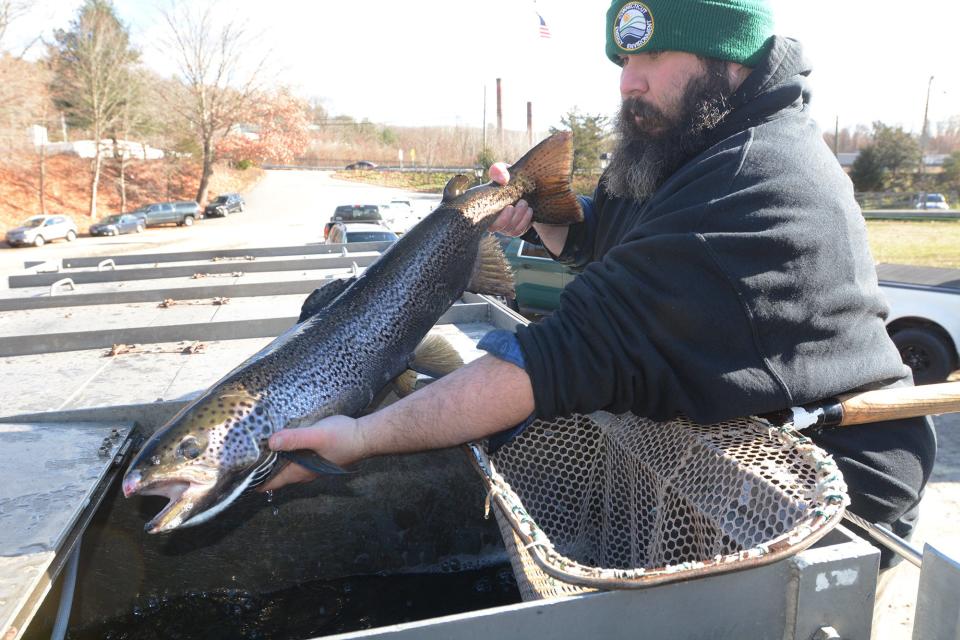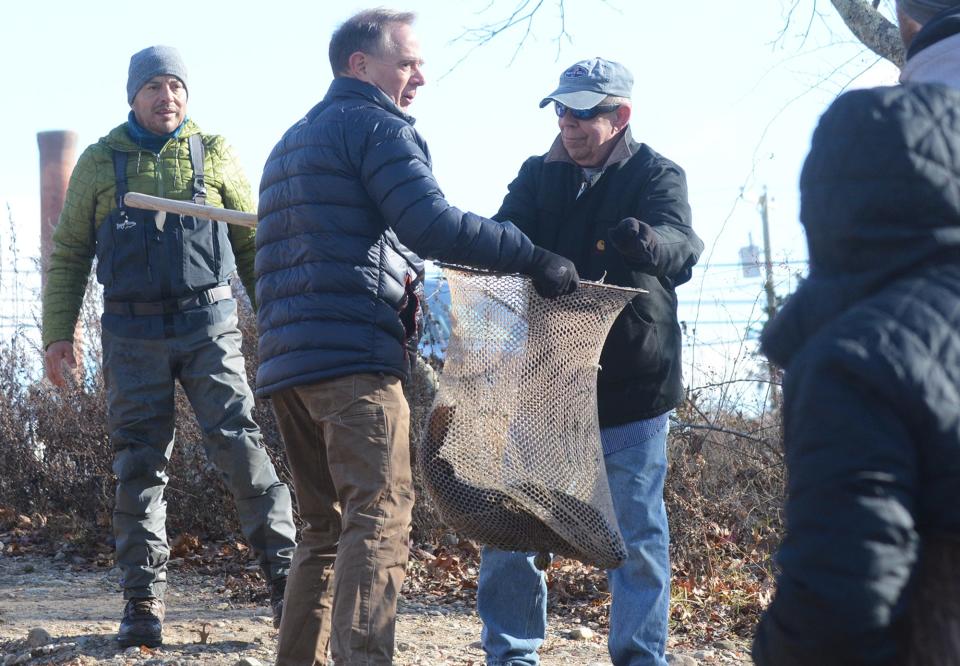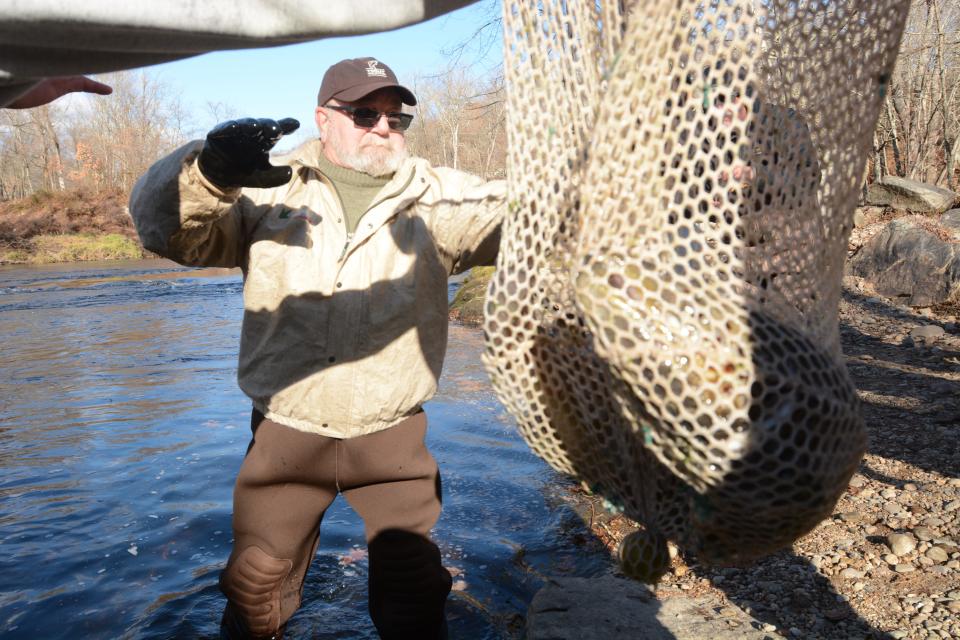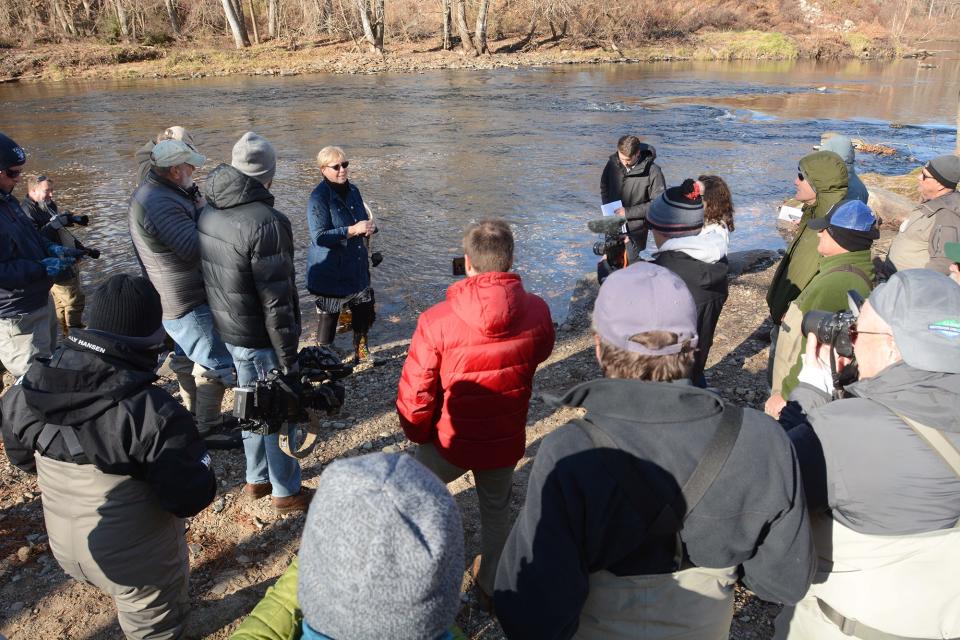Catch your own salmon? Try for one of the 10-pounders released in Shetucket River Friday.
BALTIC — Fifty Atlantic salmon hit the waters of the Shetucket River on Friday as part of a continuing effort to support recreational fishing in the area and across the state.
“If we didn’t stock, the population would disappear pretty quickly,” said Jamie Hays, a hatchery supervisor for the state’s Department of Energy and Environmental Protection, DEEP, based in Kensington.
Hays explained the stocking process through splashes from flopping fish Friday at Sprague River Park in Baltic, where 13 of the nearly 4-year-old salmon were released around 11 a.m. The rest of the fish, which weighed about 10 pounds on average, were released at various points along the river.

Fish were lifted from the tanks of a modified “stocking truck” before being carried by 20 or so volunteers 50 yards to the river.
Throughout the year, state hatchery crews release the salmon and trout into two rivers, the Shetucket in Eastern Connecticut and the Naugatuck River in the western section of the state. Each release is timed around the hatching cycle and based on the age of the fish.
Hays, who is allergic to salmon and more bird-enthusiast than a fisherman, said he takes up residence at the Kensington hatchery, one of three owned by the state, alternating weeks with another manager in order to monitor pumping systems.
For salmon alone, he said, the fish facility contains about 300 “brood fish,” used to harvest eggs, along with 1,800 two-year-olds and 3,000 one-year-olds.
But the primary point of the fish-release is less to revive the once abundant resource of wild Atlantic salmon swimming in rivers across Connecticut and more about the fishing.
“We don’t anticipate that they are going to live forever out here,” Director of Fisheries for the state, Peter Aarrestad said, from the banks of the Shetucket Friday. “They will hang around in the river over the winter hopefully and hopefully provide some recreation.”
Known as the “King of Fish,” Atlantic salmon can live in both fresh and saltwater. Once native to almost every coastal river north of the Hudson River in New York, the last species surviving today are found only, and sparsely, in eight rivers in Maine.
The decline of the species locally began in the late 1800s as the industrial footprint in the U.S. grew directly from the power of the region’s fast flowing rivers, which served as a power supply for local factories.
“Dams, in particular, were a major problem,’ said Aarrestad, in addition to over-fishing and pollution. "Building dams [prevented] the fish from getting to the areas where they spawn.”

With help from funding supplied by U.S. Fish and Wildlife in the late 1960s, the state of Connecticut and four others in New England started what was then known as the “Atlantic Salmon Restoration Project,” which brought together public and private groups with the goal of managing the fish population in the Connecticut River Basin only.
In 1983, the Connecticut River Atlantic Salmon Compact formed under further federal legislation designed to bring groups together to support the management of the Atlantic salmon populations in the Connecticut River, with a goal to restore its populations.
The state’s top fisheries official joined the cause in the 1980s and recalled how he and a colleague stationed at the Rainbow Dam Fishway on the Farmington River caught 13 salmon during a shift in an effort to harvest their fish eggs.
“We got them measured and did all of that,” he said. “We were like, giddy, we couldn’t believe it.”
By 1991 officials identified the “actual stocking of those fish for recreational purposes,” as an intended beneficiary of the restoration effort and the push to restock the salmon in the state found another outlet.

“We were having surplus broodstock on our hands and we wanted to do something with the fish,” said Aarrestad. “Because we were doing that anyway, we needed the source of fish to produce the eggs and that is what you saw stocked here today.”
As the repopulating efforts continued, a lift for the fishing stock side of things came in 2011 with the destruction of the U.S. Fish and Wildlife agency’s White River National Fish Hatchery at the hands of Tropical Storm Irene.
“Changing water conditions and moving food sources had already threatened the federal program,” Aarrestad said.

Still, even as the federal agency and other states removed themselves from the effort following Irene, Connecticut’s environmental agency pushed on.
Today, the state’s hatcheries continue to operate to raise and release fish stock into key water bodies in the state; but the effort has shifted to supporting recreational fishing.
“This spring we had three wild adult Atlantic salmon swim up the Farmington River through the Rainbow Fishway and up into the waters of the Farmington river basins.” He said. “It was sort of amazing because we are not stocking much in the way of [juvenile salmon] anymore.”
This article originally appeared on The Bulletin: Conn. releases 50 Atlantic salmon into Shetucket River for fishing

